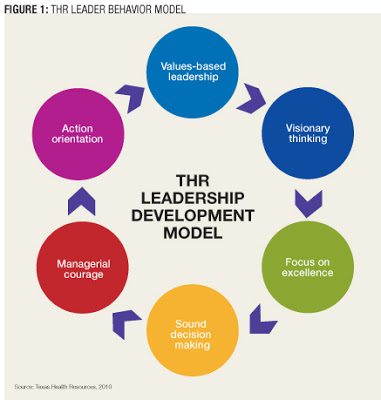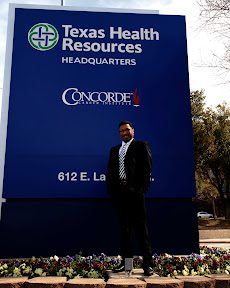It all started with a performance review and a white lab coat. Jim Dunn, chief learning officer for Texas Health Resources (THR), began his career as a research scientist at Georgia Tech, where he ran several of the university labs involving toxicological testing. His next move was to Amoco Corp., where he became a regulatory toxicologist doing pretty much the same thing. Six years passed. Dunn was tired of the lab coat and only having mice for company, so when his supervisor learned he wanted to shed his solitary work environment and do something with people, he offered a new opportunity: as the director of HR.
“I had no training, no background, I didn’t even know what he meant. I said, ‘you mean like the personnel folks?’ He said, ‘Yeah, like the personnel folks.’ I said, ‘Dr. White, I appreciate that but I don’t know anything about it.’ He said, ‘I think you could learn it.’ I went from regulatory toxicologist to a director of HR with responsibility for 6,000 employees.”
The rest, as they say, is history. Dunn fell in love with HR, gravitating toward the learning and development and strategy aspects. He went from Amoco to running HR operations for former President Jimmy Carter, which was smaller in scale but large in learning.
“That’s where I really developed the skills, the importance of understanding and getting to know your employees. Of course, I could do that with 200 versus 6,000. From there I was pretty much sold that I was an HR OD professional. I was not going back to the sciences. By that time I had picked up multiple graduate degrees in HR and OD, and I was later recruited away from President Carter to work for the American Cancer Society. That’s where I spent the last 10 years before joining THR in ’08.”
Texas Health Resources is the largest nonprofit health care delivery system in north Texas, with some 23,000 employees serving roughly 6.2 million people in 24 acute care and short stay hospitals in the Dallas-Fort Worth area.
Before Dunn joined the team at THR’s Center for Learning and Career Development, he said the corporate learning entity was made up of astute trainers and facilitators.
They could engage an audience and provide all types of HR or clinically related training, but there was no strategy or alignment to organizational goals. In his first six months on the job, he took the company’s 10-year strategic plan and stripped it down to learning and development objectives, which had never been done before.
“The finance people were blown away because they typically look at learning and HR and other things as overhead, not necessarily as business drivers,” he said. “I spent a few months with the executive committee showing them that these learning objectives will bring as strong of an ROI as the clinical and financial objectives.
Now we sit within the center for learning with 10 clinical and non-clinical service lines.”
Some of the lines include instructional and curriculum development, measurement and evaluation and leadership development. Leadership development programs and services are designed to enhance the capability of the top 200, typically senior directors and officers, and include succession, 360 assessment and coaching. Management and professional development for general staff up to the director level, roughly 3,000 employees, is another service line which targets work and group dynamics, training, new manager assimilation, mentoring and more than 100 courses on things such as adapting to change, building teams and critical thinking for clinical and non-clinical leaders.
“The faculty of our Center for Learning is constantly scouring the environment to look at the latest techniques for both teaching and for the procedures that we do from a behavioral standpoint,” said Douglas D. Hawthorne, CEO of THR. “Jim is involved in many of our executive team meetings across the system to learn about new techniques, new learning opportunities. We come at it from a variety of ways in order to gain knowledge about how we want to advance the organization.”
Leadership development is one of Dunn’s favorite parts of his job, and while THR makes special provisions for its top 200, he said everyone in the organization has the capacity to demonstrate leadership and should be encouraged to do so because it’s a learned trait, not a title.
“You will have people who clean hospital beds who are leaders and have more to do with the perception of patients than the president of the hospital,” he said. “For me it’s always been a passion that more than just people with the title be developed. The ability to adapt to change, to motivate others, to have empathetic conversations with clients and patients, being involved in that process of elevating and raising the capabilities and competencies of others, for me, it’s great. Money is not the real motivation. It’s the reward of what you do with other people to build success in their careers.”
Having internal motivation and joy in one’s work is helpful when the industry is in flux, which health care is. Dunn said industry changes are his greatest challenge right now. A traditionally static fee-for-service model — get sick, go to the doctor, get treated, billed, then pay — is gone post-health care reform. Now hospitals have to take care of patients as they present themselves, ensure the quality of care and wrap prevention around that.
Dunn said some 34 million people who are uninsured will have insurance by 2013. To take care of those people, increase quality and increase physician and clinical workloads without practitioners suffering burnout creates a prime opportunity for learning, and leadership development in particular, to have a strategic impact. To that end, Dunn and his team have developed the THR Leadership University, a comprehensive corporate university for clinical, leadership and management staff. The university offers THR’s first succession planning groups to identify next-generation leaders as well as high-potential leadership groups.
“You cannot name an aspect of this huge 24-hospital system where my folks are not working somewhere, driving and building the talents of others,” he said.

Dunn and his team also have developed the THR Leader Behavior Model (Figure 1), a six-pillar construct that directs curriculum development for the top 200 THR leaders, who have 24 hours of required training per year. “Let’s say there are 30 outcomes on the business plan. In order to make those happen there’s going to have to be a change in leader behavior because if what we’re doing today is not delivering those outcomes then we need to do something different.”
“He has taken the organization through a nine-month research process to understand and define what are the competencies of a true Texas Health Resources Leader,” Hawthorne said. “Most important were the interviews with our own leadership across the organization to talk about what competencies they feel are critical to be an effective leader. Once that research was done, Jim and his team created the context or material to advance these six pillars to help advance THR leaders going forward.
Now we have people from all over the country coming to study the development of our leadership training and our model.”
Dunn, an avid student and teacher as well as practitioner, doesn’t seem surprised at the attention his efforts have drawn in the industry. He said he will never allow himself to become so comfortable having a certain title, income or even respect from his THR peers and CEO that he stops learning himself. He said there’s too much riding on his continued momentum in the business, and it goes against his personal motivation and philosophy around continuous learning.
“When I get in conferences and I hear the learning leader say, ‘my CEO or my leadership, they just don’t get it,’ what I interpret that as is, they don’t get it because you don’t help them get it. The only way I can help my leadership get it is to stay developed and as well-read in the business as they are. I read the same books the CEO and the leadership teams are reading. I’m looking at the same positive or negative trends and performance in the organization, and I’m thinking about the things that keep them up at night. Then I go back into my learning world to find what I have in my arsenal of learning and development that will assist them.”
Dunn said too often within HR, learning and some of the other operational areas leaders become really good at what they do — excellent finance people, compelling trainers or people-savvy facilitators — but however fabulous or expert people become in a particular area, without a broader organizational perspective they will remain outside of the business.
“I know every year my focus is going to be very different,” Dunn said. “For example, nothing that I shared with you of the past three years — you never heard me say the word physician or physician leadership development because we focused primarily on nursing, ally health and general staff. In 2012 one of our two driving business priorities is the alignment between physician leaders and non-physician leaders within the health care system. My focus this year will be on building great physician leaders. Have I done this before? No. Am I excited about doing it? Absolutely, and I have immersed myself in physician leadership and the constructs of being a physician: how they’re trained in school, how that’s very different from how the MBA and MHA types are trained in school, and how you bring these two together. I’ve taken it on as my task because that is where we are right now.”
Whatever his focus is at any given time, Dunn said measuring the impact of learning and development efforts on THR’s strategic business plan is critical. The measurement service line within the corporate university was built to ensure that ROI is more than just smile sheets and compliments. In the past he said when he asked his staff, “how do we know this training effort is working, they gave answers like, Dr. So and So loves it,” and other people-related feedback. But being asked to come back and deliver a program multiple times doesn’t necessarily mean its adding value to the business.
Dunn deliberately brought in a Ph.D. industrial organizational psychologist not from health care, but from general industry because he said he knew the person would bring a different perspective. THR also does its own needs assessment and has created a 360 assessment tool in house that allows real-time leader effectiveness measurement. “At the end of the year we can tell each of our top 200 leaders how they’ve progressed in their role and in their behavior around [the THR behavior model] constructs,” he said.
THR is five years into its 10-year strategic vision, and Hawthorne said the center for learning has done much to advance the organization and to create a value proposition for the organization to serve patients, their families, the community and THR physicians and staff.
“The center for learning under Jim’s leadership helps provide some of the materials to allow us to keep this vision in front of our employees each and every day,” he said. “But more importantly Jim is an individual who understands our mission and our vision and values and lives those. It’s not just about teaching, it’s also about learning, and he’s constantly involved in doing that. We believe the Center for Learning and our university are truly things that evolved through Jim’s expertise, knowledge and commitment.”
Kellye Whitney is managing editor of Chief Learning Officer magazine. She can be reached at kwhitney@CLOmedia.com.















